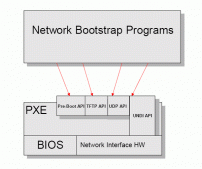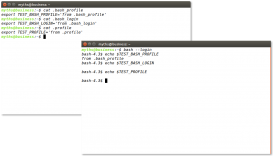本文研究的主要是Linux进程函数fork(),vfork(),execX()的相关内容,具体介绍如下。
函数fork()
fork函数:创建一个新进程
1、fork()成功后,将为子进程申请PCB和用户内存空间。
2、子进程会复制父进程用户空间的所有数据(代码段、数据段、BSS、堆、栈),文件描述符。
3、复制父亲进程PCB中绝大多数信息。
4、虽然子进程复制了文件描述符,而对于文件描述符相关的文件表项(struct file结构),则采用共享的方式。
一个实例:
|
1
2
3
4
5
6
7
8
9
10
11
12
13
14
15
16
17
18
19
20
21
22
23
24
25
26
27
28
29
30
31
32
33
34
35
36
37
38
39
40
|
#include <unistd.h> //fork fuction#include <fcntl.h> //file operator#include <sys/types.h>#include <stdio.h> #include <stdlib.h> //exit fuction#include <string.h>int main() { pid_t pid; int i=1; int status; char *ch1="hello",*ch2="world",*ch3="IN"; int fd; if ((fd=open("fork.txt",O_RDWR|O_CREAT,0644))==-1) { perror("not open"); exit(EXIT_FAILURE); } if (write(fd,ch1,strlen(ch1))==-1) { //write in fork.txt perror("not write"); exit(EXIT_FAILURE); } if ((pid=fork())==-1) { perror("fork error"); exit(EXIT_FAILURE); } else if(pid==0) { //son process int i=2; //change i printf("child:i=%d\n",i); if (write(fd,ch2,strlen(ch2))==-1) perror("child write"); return 0; } else { sleep(1); printf("parent:i=%d\n",i); if (write(fd,ch3,strlen(ch3))==-1) perror("child write"); wait(&status); return 0; }} |
运行:
|
1
2
3
4
|
[root@localhost linux]# gcc -o fork fork.c [root@localhost linux]# ./fork child:i=2 parent:i=1 |
可以看到在子进程中改变了i的值,然而父进程i仍为1,所以说子进程和父进程有自己的用户空间。而打开所创建的fork.txt可以得到hellowordIN,父子进程共同对一个文件操作写入的数据是不交叉覆盖的,说明父子进程共享文件偏移,一次共享文件表项。
函数vfork()
与fork()函数不同,vfork()函数在创建进程是并不复制父进程的地址空间,而是在必要的时候才申请新的存储空间,因此使得vfork()更有效率。
特别注意的是vfork()是共享父进程的代码以数据段。
一个例子:
|
1
2
3
4
5
6
7
8
9
10
11
12
13
14
15
16
17
18
19
20
21
22
23
24
|
#include <unistd.h> //fork fuction#include <fcntl.h> //file operator#include <sys/types.h>#include <stdio.h> #include <stdlib.h> //exit fuction#include <string.h>int i=10;int main() { pid_t pid; if ((pid=fork())==-1) { perror("fork error"); exit(EXIT_FAILURE); } else if(pid==0) { //son process i++; printf("child:i=%d\n",i); _exit(0); } else { sleep(1); printf("parent:i=%d\n",i); return 0; }} |
注意:上面的代码中回收子进程用的是_exit(0),如果用return 0;的话它会回收用户空间,因此在父进程调用的时候会出现段错误。
下面是调用输出结果:
|
1
2
3
4
5
6
7
|
如果以fork()创建则会输出: [root@localhost linux]# ./fork child:i=11 parent:i=10 如果改为vfork(),则: child:i=11 parent:i=11 |
函数exec X()系列函数
用fork()函数创建紫禁城后,如果希望在当前子进程中运行新的程序,则可以调用execX系列函数。
注意:当进程调用exec函数后,该进程的用户空间资源完全有新程序代替。
这些函数的区别在于:
1、指示新程序的位置是路径还是文件名
2、在使用参数时是使用参数列表哈市使用argv[]数组
3、后缀有l(list)表示使用参数列表,v表示使用argv[]数组
具体如下所示:
|
1
2
3
4
5
6
7
8
9
10
|
#include<unistd.h>int execl(const char *pathname,const char *arg0,.../*(char *) 0 */);int execv(const char *pathname,char *const argv[]);int execle(const char *pathname,const char *arg0,.../*(char *) 0 ,char *const envp[] */);int execve(const char *pathname,char *const argv[],char *const envp[]);int execlp(const char *filename,const char*arg0,.../*(char *) 0*/);int execvp(const char *filename, char *const argv[]);int fexecve(int fd,char *const argv[],char *const evnp[]); |
一个实例:
|
1
2
3
4
5
6
7
8
9
10
11
12
|
#include <unistd.h>#include <stdio.h>#include <sys/types.h>int main(int argc ,char* argv[]) { pid_t pid; if ((pid=fork())==-1) printf("error"); else if (pid==0) execl("/bin/ls","ls","-l",argv[1],(char *)0); else printf("father ok\n");} |
运行可以看到在子进程中执行了ls命令。
|
1
2
|
[yqtao@localhost linux]$ gcc -o exec execX.c[yqtao@localhost linux]$ ./exec /home father ok |
//execlp()函数使用
|
1
2
3
4
5
6
|
#include <unistd.h>#include <stdio.h>#include <sys/types.h>int main(int argc ,char* argv[]) { execlp("ls","ls","-l","/home",(char*)0);} |
//execv()函数的使用
|
1
2
3
4
5
6
7
|
#include <unistd.h>#include <stdio.h>#include <sys/types.h>int main(int argc ,char* argv[]) { char* argv1[]={"ls","-l","/home",0}; execv("/bin/ls",argv1);} |
ecvp()会从环境变量PATH所指定的目录中查找文件名作为第一个参数,第二个及以后的参数由参数列表,注意最后一个成员必须为NULL
|
1
2
3
4
5
6
7
|
#include <unistd.h>#include <stdio.h>#include <sys/types.h>int main(int argc ,char* argv[]) { char* argv1[]={"ls","-l","/home",0}; execvp("ls",argv1);} |
总结
以上就是本文关于深入解读Linux进程函数fork(),vfork(),execX()的全部内容,希望对大家有所帮助。感兴趣的朋友可以继续参阅本站其他相关专题,如有不足之处,欢迎留言指出。感谢朋友们对本站的支持!
原文链接:http://blog.csdn.net/taoyanqi8932/article/details/52778015















